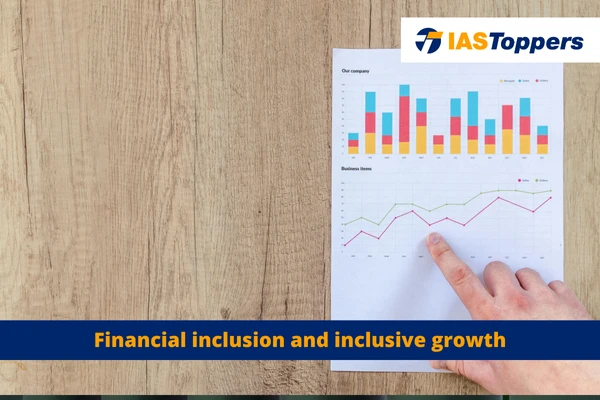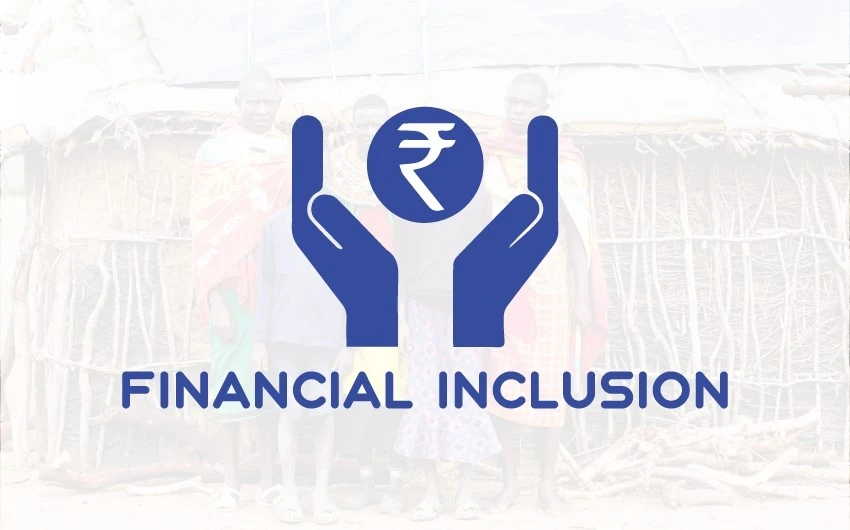Financial inclusion refers to efforts to make financial products and services accessible and affordable to all individuals and businesses, regardless of their personal net worth or company size. Financial inclusion is a major step towards inclusive growth which ensures the overall economic development of the marginalised sections of the society. This article will give you brief information about financial inclusion, its objectives, and importance, initiatives by Indian governments for improvement, etc.
This article is an important topic for GS Paper-3 Economy Subject of UPSC IAS Exam.
Content
- About financial inclusion
- Objectives of Financial Inclusion
- Financial Inclusion Schemes in India
- About Inclusive growth
- Inclusive Development Index (IDI)
- Challenges in inclusive growth
- Government initiatives to achieve Inclusive growth in India
- Conclusion
- FAQs
About Financial Inclusion:
- Financial inclusion refers to efforts to make financial products and services accessible and affordable to all individuals and businesses, regardless of their personal net worth or company size.
- It emphasises removing the barriers that exclude people from participating in the financial sector and using these services to improve their lives.
- It is also called inclusive finance.
- Overall innovation, economic growth, and consumer knowledge can be enhanced with financial inclusion.
- Financial inclusion is a key enabler in reducing poverty and boosting prosperity.
- The World Bank Group considers financial inclusion a key enabler to reduce extreme poverty and boost shared prosperity.
- Being able to have access to a transaction account is a first step towards broader financial inclusion since a transaction account allows people to store money, and send and receive payments.
Objectives of Financial Inclusion:
- Economical prices: Financial inclusion intends to help people secure financial services and products at low prices such as deposits, fund transfer services, loans, insurance, payment services, etc.
- Financial sustainability: financial sustainability can be provided with financial inclusion so that the less fortunate people have a certainty of funds that they struggle to have.
- Economically underprivileged sections of society: Awareness can be increased about the benefits of financial services among the economically underprivileged sections of society.
- Financial products: The process of financial inclusion works towards creating financial products that are suitable for the less fortunate people of society.
- Financial literacy: Financial inclusion intends to improve financial literacy and financial awareness in the nation.
- Digital financial solution: Financial inclusion aims to bring in digital financial solutions for the economically underprivileged people of the nation.
- Mobile banking: It also intends to bring in mobile banking or financial services in order to reach the poorest people living in extremely remote areas of the country.
- It aims to provide tailor-made and custom-made financial solutions to poor people as per their individual financial conditions, household needs, preferences, and income levels.
- Financial inclusion activities target women by helping them get engaged in financial management.
- With the help of financial inclusion, the government, as well as non-governmental agencies are trying to remove mentality of society that women cannot handle money.
- Subsidised or Discounted interest rates: Many banks charge discounted interest rates to women for their loan products.
- For savings accounts offered by certain banks and non-banking financial corporations, women depositors gain more interest on their deposits when compared to men.
Financial Inclusion Schemes in India:
These schemes intend to provide social security to weaker sections of society. These schemes have been launched over different years.
- Pradhan Mantri Jan Dhan Yojana (PMJDY)
- Atal Pension Yojana (APY)
- Pradhan Mantri Vaya Vandana Yojana (PMVVY)
- Stand Up India Scheme
- Pradhan Mantri Mudra Yojana (PMMY)
- Pradhan Mantri Suraksha Bima Yojana (PMSBY)
- Sukanya Samriddhi Yojana
- Jeevan Suraksha Bandhan Yojana
- Credit Enhancement Guarantee Scheme (CEGS) for Scheduled Castes (SCs)
- Venture Capital Fund for Scheduled Castes under the Social Sector Initiatives
- Varishtha Pension Bima Yojana (VPBY)
About Inclusive growth:
- Inclusive growth is economic growth that is distributed fairly across society and creates opportunities for all.
- It raises standards of livings for broad swaths of a population.
- Inequitable growth may have adverse political outcomes and affect Inclusive growth.
- The Union Budget 22-23 lays the foundations for “Amrit Kaal” and has made “Inclusive Development” the buzz word for 2022.
Inclusive Development Index (IDI):
- IDI aims to inform and enable sustained and inclusive economic progress through deepened public-private cooperation through thought leadership and analysis, strategic dialogue and concrete cooperation.
- It is an annual assessment of countries’ economic performance by the World Economic Forum.
- It measures how countries perform on eleven dimensions of economic progress in addition to GDP.
- The IDI is a project of the World Economic Forum.
- It has 3 pillars:
- growth and development
- inclusion and
- intergenerational equity
Challenges in inclusive growth:
- Unemployment
- Unequal distribution of wealth
- Lack of Education
- Social issues
- Gender inequality
Government initiatives to achieve Inclusive growth in India:
- Sarva Shiksha Abhiyan (SSA)
- National Rural Health Mission (NRHM)
- Protection of Civil Rights Act, 1955
- Scheduled Castes and Scheduled Tribes (Prevention of Atrocities) Act, 1989
- Deendayal Antyodaya Yojana- National Urban Livelihoods Mission (DAY-NULM)
- Pt. Deen Dayal Upadhyaya Grameen Kaushalya Yojana (DDU-GKY)
Initiatives by OECD for inclusive growth:
- Centre on Well-being, Inclusion, Sustainability and Equal Opportunity (WISE)
- Business for Inclusive Growth (B4IG)
Conclusion
Financial inclusion refers to the efforts made to make financial services accessible at affordable costs to all individuals and businesses, regardless of their net worth or company size. It involves providing a diverse range of financial services such as deposits, loans, payment services, money transfers, and insurance to poor and low-income households and their microenterprises.
Ref:Source-1
| Other Articles in Economy | |
| Startup Ecosystem | Sectors of Indian Economy |
| New Industrial Policy 1991 | Narasimham Committee I and II |
| Pre-Independence Economy of India | Infrastructure investment trusts (InvITs) |
FAQs (Frequently Asked Question)
What are the 4 pillars of financial inclusion?
Technology, women inclusion, financial literacy and regulation.
What is the main aim of financial inclusion?
It primarily aims to include everybody in the society by giving them basic financial services without looking at a person’s income or savings.




